

Why CRA? First, I have a quiz for you. If you speak and write Hindi, you can skip this quiz. For the rest of you, look at the symbols below. Can you tell which are letters and which are numerals? Symbols 1 and 4 are numbers, while symbols 2 and 3 are letters. How did you do? This post contains affiliate links, which simply means that when you use my link and purchase a product, I receive a small commission. Think of the picture at the top of this post. My point here is not only the importance of the CRA sequence of instruction, but also that the majority of our students are getting far too little concrete and pictorial experiences with key concepts, and that is a major cause of their lack of understanding.
How important is CRA? A few comments about these standards. Three final notes. The CRA sequence of instruction is for all grade levels, not just the primary grades. You might also like... Twitter. Twitter. Virtual Manipulatives for Math. Free Math Apps. Brainingcamp. Multiply Whole Number by a Fraction Multiply Fraction by a Whole Number Division with Unit Fractions Addition as Count and Measure Comparing Multi-Digit Numbers Division with a Remainder Improper Fractions to Mixed Numbers.

Mathematical Modelling. These virtual math manipulatives support teachers to model abstract mathematical concepts for deeper student comprehension.
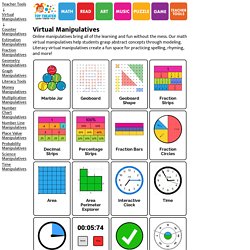
Similar to manipulatives that have been used for decades by teachers in classrooms, these online math manipulatives for elementary school classrooms offer numerous advantages while retaining the benefits of the classic manipulatives. According to Moyer, Niezgoda, and Stanley (2005): “Virtual manipulatives are uniquely suited for teaching mathematics with young children. A Web connection makes them free of charge and easily available. Some virtual manipulatives have the potential for alteration. Twitter. Twitter. Twitter. Twitter. Twitter. Math Manipulatives□ - Google Slides. Scavenger Hunts to Equip Students for Remote Learning. As each new school year begins, teachers consider how to help students build confidence with the tools and manipulatives they will use throughout the year.

In Work Places, for example, we allow students to explore materials like Unifix cubes, pattern blocks, and dominoes before they use them in actual gameplay. In this relaxed setting, students generate interest and excitement in classroom resources while they investigate materials and establish norms for their use and care. This year, as many teachers get ready for remote—or socially distant—learning, they may be asking how to best prepare students to use digital, rather than physical, tools. To support this process, MLC has designed a set of digital scavenger hunts to provide a guided discovery experience with the tools that students will likely use in a remote setting.
Digital Scavenger Hunts (Google Slides; you will be required to make a copy) Let’s take a look at a few examples. Draggable Objects Let’s take a look at a few examples. Twitter. Virtual Manipulatives Resources – Google Drive. “Making Math Visual” TEDxOrangeCoast - Matthew Peterson - Teaching Without Words. Technology and the CRA Sequence of Instruction - Math Coach's Corner. I got an email from a reader last week asking about the impact of technology on the CRA sequence of instruction, so I thought I’d blog about it.
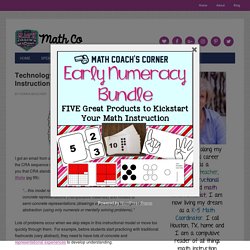
First, let me remind you that CRA stands for concrete, representational, and abstract. From Van de Walle (pg 99): “…this model reflects a sequence that moves from an instructional focus on concrete representations (manipulative materials) and models to semi-concrete representations (drawings or pictures) and images to abstraction (using only numerals or mentally solving problems).” Lots of problems occur when we skip steps in this instructional model or move too quickly through them. For example, before students start practicing with traditional flashcards (very abstract), they need to have lots of concrete and representational experiences to develop understanding. Van de Walle makes a great point, however, that the stages need to overlap. Now back to the original question about technology.
I hope this all makes sense. Concrete Representational Abstract (CRA) in mathematics. In response to a Twitter inquiry, I decided to write up some longstanding thoughts on the Concrete Representational Abstract (CRA) sequence that is popular particularly in designing instruction for learners with disabilities.
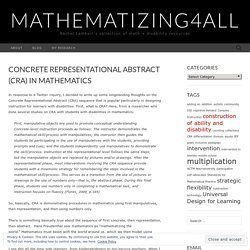
First, what is CRA? Here, from a researcher who done several studies on CRA with students with disabilities in mathematics: First, manipulative objects are used to promote conceptual understanding. Concrete-level instruction proceeds as follows: The instructor demonstrates the mathematical skill/process with manipulatives; the instructor then guides the students by participating in the use of manipulatives with the students, providing prompts and cues; and the students independently use manipulatives to demonstrate the skill/process. Instruction at the representational level follows the same steps, but the manipulative objects are replaced by pictures and/or drawings.
Using Number Bracelets to Develop Number Sense. I’ve blogged recently about using dot cards and rekenreks to develop number sense, and today’s post focuses on another great tool–number bracelets.

Like dot cards and rekenreks, number bracelets provide concrete practice for number combinations and composing/decomposing numbers. Making Number Bracelets Use chenille stems (cut off about 2″) and pony beads to make the bracelets. You don’t need to worry about sizing them to fit students–they don’t actually wear them, they manipulate the beads. Notice these are also two of the materials used to make the rekenreks, so buy in bulk! I Love Number Lines! Number lines are such an incredibly powerful tool, and I think sometimes they get underutilized.
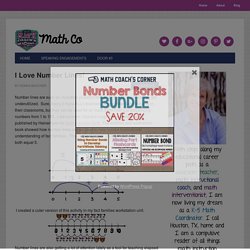
Sure, many (I hope ALL!) Teachers have number lines hanging in their classrooms, but they can be used for so much more than just sequencing numbers from 1 to 100. Last summer, I found a couple of great new books published by Heinemann for teaching basic facts. The addition and subtraction book showed how number lines can be used to help build a foundational understanding of fact families. The example below shows that 2 + 3 and 3 + 2 both equal 5. 1996 Hands on Help. American Federation of Teachers. Tips on Using Math Manipulatives in The Classroom.
In most elementary school classrooms, you will see manipulatives – bins of blocks, cubes, counters, and other materials that aid in mathematical learning.
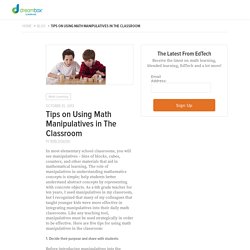
The role of manipulatives in understanding mathematics concepts is simple; help students better understand abstract concepts by representing with concrete objects. As a 6th grade teacher for ten years, I used manipulatives in my classroom, but I recognized that many of my colleagues that taught younger kids were more effective in integrating manipulatives into their daily math classrooms.
Like any teaching tool, manipulatives must be used strategically in order to be effective. Here are five tips for using math manipulatives in the classroom: 1. Before introducing manipulatives into the classroom, teachers need to know why the objects are helpful in helping their students discover and learn. 2. 3. 4. 5.
Looking for more innovative ways to help your students learn math? Kelly Urlacher Curriculum Designer at DreamBox Learning. Why Teach Mathematics with Manipulatives - ETA hand2mind. In order to implement formative assessment well, Wiliam (2011) shares five key strategies.
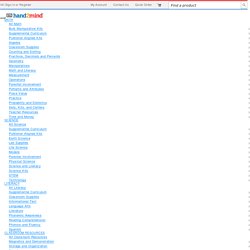
Three are particularly well-supported by manipulative-based instruction: classroom activities and learning tasks which elicit evidence of learning, activating learners as instructional resources for one another, and activating learners as owners of their own learning. In all three cases, by actively engaging students in the doing of mathematics, manipulatives provide a foundation which encourages discussion and student ownership of their work. This provides teachers with a vivid current picture of student understanding and guides teachers in determining appropriate next steps. Building on the learning theory work of Piaget and Bruner, a solid history of research supports the regular use of manipulatives in classroom mathematics instruction.
Black, P. & Wiliam, D. (1998). Bruner, J. (1966). Dienes, Z.P. (1960). Moore, S.